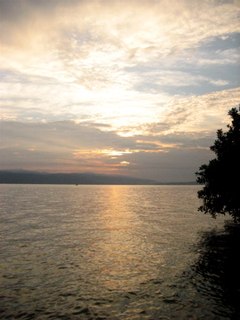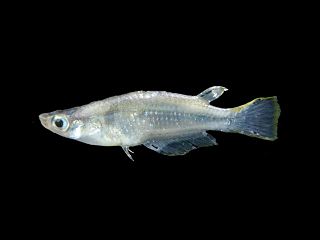
The ricefishes are a family (Adrianichthyidae) of small ray-finned fish that are found in fresh and brackish waters from India to Japan and out into the Malay Archipelago, most notably Sulawesi. The common name ricefish derives from the fact that some species are found in rice paddies. This family consists of about 37 species in two genera. Several species are rare and threatened, and some 2–4 may already be extinct.

The Japanese rice fish also known as the medaka, is a member of genus Oryzias (ricefish), the only genus in the subfamily Oryziinae. This small native of East Asia is a denizen of rice paddies, marshes, ponds, slow-moving streams and tide pools. It is euryhaline, occurring in both brackish and freshwater. It became popular as an aquarium fish because of its hardiness and pleasant coloration: its coloration varies from creamy-white to yellowish in the wild to white, creamy-yellow, or orange in aquarium-bred individuals. Bright yellow, red or green transgenic populations, similar to GloFish, have also been developed, but are banned from sale in the EU. The medaka has been a popular pet since the 17th century in Japan. After fertilization, the female carries her eggs attached anterior to the anal fin for a period before depositing them on plants or similar things.

Lake Matano, also known as Matana, is a natural lake in East Luwu Regency, South Sulawesi province, Indonesia. With a depth of 590 m (1,940 ft), it is the deepest lake in Indonesia, the 10th deepest lake in the world and the deepest lake on an island by maximum depth. The surface elevation from mean sea level is only 382 m (1,253 ft), which means that the deepest portion of the lake is below sea level (cryptodepression). It is one of the two major lakes in the Malili Lake system.
Glossogobius matanensis is a species of goby endemic to Sulawesi, Indonesia where it is only known from Lake Matano, Lake Mahalona and Lake Towuti. This species can reach a length of 42 centimetres (17 in) TL.

The dwarf rainbowfish is a species of rainbowfish in the subfamily Melanotaeniinae, also commonly known as the neon rainbowfish. It is endemic to the Mamberamo River basin in West Papua in Indonesia and common in the aquarium trade.
Oryzias celebensis, the Celebes medaka, fish in the family Adrianichthyidae. It is endemic to rivers, streams and lakes on the Indonesian island of Sulawesi and one river in East Timor.

Oryzias is a genus of ricefishes native to fresh and brackish water in east and south Asia. Some species are widespread and the Japanese rice fish is commonly used in science as a model organism, while others have very small ranges and are threatened. They are small, up to 8 cm (3.1 in) long, and most are relatively plain in colour.
Oryzias marmoratus, also known as the marmorated ricefish or marmorated medaka, is a species of fish in the family Adrianichthyidae, from Lake Towuti, Lake Mahalona, Lake Lontoa and associated streams in Sulawesi, Indonesia.
The sharp-jawed buntingi is a species of ricefish in the family Adrianichthyidae. It is endemic to Lake Poso in Sulawesi, Indonesia.
Oryzias profundicola, the yellow-finned medaka or yellow-finned ricefish, is a species of fish in the family Adrianichthyidae.
The egg-carrying buntingi is a species of fish in the family Adrianichthyidae. It is endemic to Lake Poso in Sulawesi, Indonesia.

Oryzias sarasinorum, the Sarasins minnow or Sarasins buntingi, is a species of ricefish in the Adrianichthyidae. It is endemic to Lake Lindu in Lore Lindu National Park, Sulawesi, Indonesia. This species was described as Haplochilus sarasinorum by C.M.L. Popta in 1905 and she named it in honour of the Swiss naturalists and second cousins Paul Sarasin (1856-1929) and Fritz Sarasin (1859-1942), the latter being the collector of the type. Although the IUCN state that the population of this fish is stabled it is threatened by introduced non native fish, common carp, Mozambique tilapia and walking catfish; and a decline in water quality caused by increased agriculture in the lake's catchment which is causing a decline in water quality, it is therefore assessed as Critically Endangered.

Heterandria formosa is a species of livebearing fish within the family Poeciliidae. This is the same family that includes familiar aquarium fishes such as guppies and mollies. Heterandria formosa is not as commonly kept in aquaria as these species. Despite the common name "least killifish", it belongs to the family Poeciliidae and not to one of the killifish families. H. formosa is one of the smallest fish species; the 1991 Baensch Aquarium Atlas listed it as the 7th smallest fish in the world, and as of 2006 it remains the smallest fish species found in North America.

Caridina dennerli is a small species of freshwater shrimp from Sulawesi (Indonesia) that grows up to 2.5 centimetres (1.0 in) in length. It takes its name from the German company Dennerle, which supported the expedition that led to the scientific description of the species. It is popularly known as the 'cardinal shrimp' in the aquarium trade.

Oryzias mekongensis is a species of fish in the family Adrianichthyidae. It is endemic to the Mekong River Basin in southeast Asia, where found in ditches, canals and ponds.

Oryzias javanicus, the Javanese ricefish, is a small species of fish in the family Adrianichthyidae. It lives in Peninsular Thailand, Malaysia, Singapore, and Indonesia, where it can be seen in both brackish and fresh water in ponds, ditches, mangrove, swamps, streams and canals.
Oryzias curvinotus or the Hainan medaka is a species of ricefish which is found in Quang Ninh Province in northern Vietnam and Hainan, Guangdong and Hong Kong in southern China. It is found in both fresh and brackish water. This species was described as Aplocheilus curvinotus in 1927 by J.T. Nichols and C.H. Pope with the type locality given as Nodoa, Hainan Island, China.

The Chinese rice fish is a species of fish in the genus Oryzias. This freshwater fish occurs in swamps, stagnant parts of streams, rice fields and marshes, and is up to 3.1 cm (1.2 in) long. It was formerly considered a subspecies of the Japanese rice fish. The natural range of the Chinese rice fish is in East and Southeast Asia, including the Yangtze, Mekong, Irrawaddy, Salween, Red River and Nanpangjiang basins. It has been introduced to Kazakhstan and Russia ; also spreading in the Azov basin and has been discovered in the Obytichna River in Ukraine.
Oryzias carnaticus or the spotted ricefish are a freshwater–brackish fish species native to the India, Bangladesh, Sri Lanka, and Myanmar. Their maximum length is only 3.0 centimetres (1.2 in). They are normally found near the coast, and can live in fresh water and brackish water.
Adrianichthys roseni is a species of ricefish, a member of the family Adrianichthyidae which is endemic to Lake Poso on Sulawesi. Since the holotype was collected in 1978 there have been no reports of this species and if it still exists then it has a very low population. The IUCN categorise it as Critically Endangered. The specific name honours Donn E. Rosen (1929-1986) of the American Museum of Natural History.











